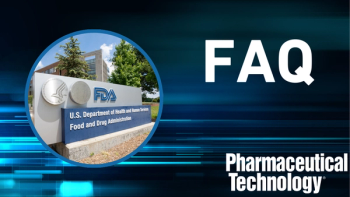
- Pharmaceutical Technology-10-02-2017
- Volume 41
- Issue 10
FDA User Fees Promote Manufacturing Readiness
Industry and FDA face new fee structures and new challenges in implementing fee initiatives.
The US Senate approved
By enacting new fee programs for drugs, biologics, generic drugs, medical devices, and biosimilars before they expired on Sept. 30, 2017, Congress avoided massive FDA layoffs. Equally important for agency staffers charged with implementing new fee policies, this user fee bill is relatively “clean,” benefitting from enactment of the extensive 21st Century Cures Act last December, which tackled many of the more controversial proposals for accelerating and streamlining the development, testing, and review of medical products.
Key provisions added to FDARA seek to spur development of pediatric cancer therapies and innovative medical devices and to deter import of illegal or counterfeit medicines. The bill reauthorizes the orphan drug grants program, while limiting orphan drug exclusivity awards to products that demonstrate a clear superiority over existing therapies, and it requires sponsors to conduct studies on new tropical disease treatments to qualify for priority review vouchers. Several provisions aim to speed up field inspections of manufacturing facilities and to assess whether delays in resolving deficiencies found in preapproval inspections block new product approvals. The legislation seeks expedited review of responses to inspection observations for priority applications and for those related to drug shortages.
Efforts to lower prescription drug prices ended up with largely symbolic language backing patient access to therapies, plus provisions for speeding the development and marketing of generic drugs to enhance market competition. FDARA establishes a priority review track for competitive generic therapies and an accelerated development initiative for high-demand products; brand manufacturers have to update information on products withdrawn from the market to help clarify which drugs have limited competition.
New fees and disclosures
This latest version of the
The overall increase in funding will help improve FDA’s electronic submission process and IT initiatives and expand programs for hiring and retaining review staff. Because PDUFA already has reduced review times for new drug applications (NDAs) by achieving more first-cycle approvals, the new PDUFA agreement focuses more on managing the mushrooming demand for development-phase meetings, boosting resources for the breakthrough drug program, advancing the review process for rare disease treatments, and bolstering support for combination products. There’s continued emphasis on advancing model-informed drug development, biomarker qualification, the use of real-world evidence, and incorporating the “patient’s voice” into regulatory decision-making.
Manufacturers of drugs, biologics, and generic drugs face added pressure to ensure that all facilities involved in product development and future production are fully identified in applications. Omitting this information in a submission can delay needed facility inspections, says FDA. Under PDUFA, applications that lack full facility information face a three-month approval delay for an NDA or efficacy supplement and two months extra for approving a manufacturing supplement. FDA states that it aims to complete all inspections of clinical and manufacturing sites within six months of accepting a priority application and within 10 months for standard submissions, leaving two months at the end of the review process to address deficiencies found during site visits.
FDA’s
The BSUFA program will advance through publication of guidance on key regulatory issues, including statistical methods for demonstrating similarity and a final policy for developing interchangeable biosimilars. FDA published
The revised
Moving on
A number of key issues failed to make it into FDARA, largely to avoid legislative delay, but they may linger, as Congress is under pressure to deal with the federal budget and tax reform proposals by year-end. One topic that could surface is a proposal for establishing user fees to support expedited review and
Another high-profile topic is the right-to-try (RTT)
References
1. H. R. 2430,
2. FDA,
3. FDA,
4. FDA,
5. FDA,
6. FDA, “Generic Drug User Fee Rates for Fiscal Year 2018,”
7. FDA,
8. US Congress,
Article Details
Pharmaceutical Technology
Volume 41, Number 10
October 2017
Pages: 16–18
Citation
When referring to this article, please cite it as J. Wechsler, “FDA User Fees Promote Manufacturing Readiness," Pharmaceutical Technology 41 (10) 2017.
Articles in this issue
about 8 years ago
Managing Potentially Potent APIsabout 8 years ago
Pharma’s Role in Puerto Rico’s Futureabout 8 years ago
Starting Early is Key to De-Risking Drug Developmentabout 8 years ago
Formulation Strategies in Early-Stage Drug Developmentabout 8 years ago
Pharmaceutical Environmental Pollution and Antimicrobial Resistanceabout 8 years ago
A Closer Look at Prefilled Syringesabout 8 years ago
Testing and Simulation Approaches for Single-Use Bioreactor Scale-upabout 8 years ago
Up and Away, M&Aabout 8 years ago
Making Decisions Based on Riskabout 8 years ago
Lab Line for Developing Drug Implant TechnologyNewsletter
Get the essential updates shaping the future of pharma manufacturing and compliance—subscribe today to Pharmaceutical Technology and never miss a breakthrough.




